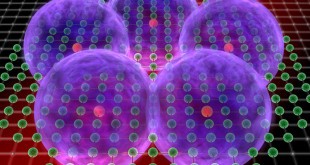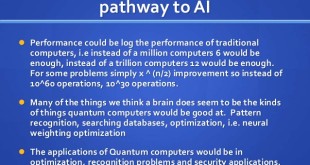We are in midst of the second quantum revolution moving from merely computing quantum properties of systems to exploiting them. Researchers are developing new capabilities in secure communication, ultra-sensitive and high signal to noise physical sensing of the environment and Quantum Information Science (QIS). Quantum sensing has become a distinct and rapidly growing branch of research within the area of quantum science and technology, with the most common platforms being spin qubits, trapped ions and flux qubits. Quantum sensors are just becoming commercially available.
Quantum sensors are measuring device that takes advantage of quantum correlations, such as states in a quantum superposition or entanglement, for better sensitivity and resolution than can be obtained by classical systems. A quantum sensor can measure the effect of the quantum state of another system on itself. The mere act of measurement influences the quantum state and alters the probability and uncertainty associated with its state during measurement. For decades, quantum measurements have been used in metrology to define fundamental constants such as time. More recently, this approach is being applied to sensing.
Superposition states are naturally very sensitive to the environment, and can therefore be used to make very accurate sensors. As a result of steady progress in material quality and control, cost reduction and the miniaturisation of components such as lasers, these devices are now ready to be carried over into numerous commercial applications.Solid-state quantum sensors, such as NV centres in diamond, have been shown to be useful for measuring very small magnetic fields.
This in turn may help with multiple applications, ranging from biosensors to magnetic resonance imaging and the detection of defects in metals. Superconducting quantum interference devices are one example of an early quantum technology now in widespread use, in fields as diverse as brain imaging and particle detection.
Quantum imaging devices use entangled light to extract more information from light during imaging. This can greatly improve imaging technologies by, for example, allowing higher resolution images through the use of squeezed light or creating the ability to produce an image by measuring one single photon which is entangled with a second, differently colored and entangled photon that is being used to probe a sample.Atomic and molecular interferometer devices use superposition to measure acceleration and rotation very precisely. These acceleration and rotation signals can be processed to enable inertial navigation devices to navigate below ground or within buildings. Such devices can also be used to measure very small changes in gravitational fields, magnetic fields, time or fundamental physical constants.
Just as classical (or non-quantum) algorithm is a finite sequence of instructions, or a step-by-step procedure for solving a problem, where each step or instruction can be performed on a classical computer. Similarly, a quantum algorithm is a step-by-step procedure, where each of the steps can be performed on a quantum computer. In quantum computing, a quantum algorithm is an algorithm which runs on a realistic model of quantum computation, the most commonly used model being the quantum circuit model of computation.Although all classical algorithms can also be performed on a quantum computer, the term quantum algorithm is usually used for those algorithms which seem inherently quantum, or use some essential feature of quantum computation such as quantum superposition or quantum entanglement.
What makes quantum algorithms interesting is that they might be able to solve some problems faster than classical algorithms because the quantum superposition and quantum entanglement that quantum algorithms exploit probably can’t be efficiently simulated on classical computers. Areas in which quantum algorithms can be applied include cryptography, search and optimisation, simulation of quantum systems and solving large systems of linear equations.
The most well known algorithms are Shor’s algorithm for factoring, and Grover’s algorithm for searching an unstructured database or an unordered list. Shor’s algorithms runs much (almost exponentially) faster than the best known classical algorithm for factoring, the general number field sieve. Grover’s algorithm runs quadratically faster than the best possible classical algorithm for the same task, a linear search.
Phase estimation algorithms are key protocols in quantum information processing. Besides applications in quantum computing, they can also be employed in metrology as they allow for fast extraction of information stored in the quantum state of a system. Phase estimation algorithms are building elements for many important quantum algorithms, such as Shor’s factorization algorithm or Lloyd’s algorithm for solving systems of linear equations.
There are two major classes of phase estimation algorithms, one suggested early on by Kitaev and a second originating from the quantum Fourier transform. In quantum computing, the Kitaev algorithm was run as part of Shor’s factorization algorithm and the Fourier transform algorithm was used in optics to measure frequencies.These algorithms are system-independent and can be employed in a variety of experimental settings, e.g., using NV centers in diamond for the sensitive detection of magnetic fields.
Quantum computer initially only permits us to measure individual qubits. If we want to measure a more complex observable, such as the energy described by a Hamiltonian , we resort to quantum phase estimation. The Quantum phase estimation algorithm (also referred to as quantum eigenvalue estimation algorithm), is a quantum algorithm to estimate the phase (or eigenvalue) of an eigenvector of a unitary operator. The routine prepares an eigenstate of the Hermitian operator in one register and stores the corresponding eigenvalue in a second register.
Physicists Develop Quantum-Inspired Optical Sensor
Researchers from the Moscow Institute of Physics and Technology (MIPT), joined by a colleague from Argonne National Laboratory, have implemented an advanced quantum algorithm for measuring physical quantities using simple optical tools. The technology could allow for affordable linear optical sensors with high-performance characteristics, with applications in diverse research fields such as astronomy and biology.
“We devised and constructed an optical scheme that runs the Fourier transform-based phase estimation procedure,” said study co-author Nikita Kirsanov from MIPT. “This procedure lies at the core of many quantum algorithms, including high-precision measurement protocols.”
Maximizing the sensitivity of measurement tools is crucial for any field of science and technology. Astronomers seek to detect remote cosmic phenomena, biologists need to discern exceedingly tiny organic structures, and engineers have to measure the positions and velocities of objects, to name a few examples.
Until recently, no measurement tool could ensure precision above the so-called shot noise limit, which has to do with the statistical features inherent in classical observations. Quantum technology has provided a way around this, boosting precision to the fundamental Heisenberg limit, stemming from the basic principles of quantum mechanics. The LIGO experiment, which detected gravitational waves for the first time in 2016, shows it is possible to achieve Heisenberg-limited sensitivity by combining complex optical interference schemes and quantum techniques.
A specific arrangement of a very large number of linear optical elements — beam splitters, phase shifters, and mirrors — makes it possible to gain information about the geometric angles, positions, velocities, and other parameters of physical objects. The measurement involves encoding the quantity of interest in the optical phases, which are then determined directly.
“This research is a follow-up to our work on universal quantum measurement algorithms,” said principal investigator Gordey Lesovik, who heads the MIPT Laboratory of the Physics of Quantum Information Technology. “In an earlier collaboration with a research group from Aalto University in Finland, we experimentally implemented a similar measurement algorithm on transmon qubits.”
The experiment showed that despite the large number of optical elements in the scheme, it is nevertheless tunable and controllable. According to the theoretical estimates provided in the paper, linear optics tools are viable for implementing even operations that are considerably more complex. “The study has demonstrated that linear optics offers an affordable and effective platform for implementing moderate-scale quantum measurements and computations,” Argonne Distinguished Fellow Valerii Vinokur said.
References and Resources also include
https://www.photonics.com/Articles/Physicists_Develop_Quantum-Inspired_Optical_Sensor/a65855
 International Defense Security & Technology Your trusted Source for News, Research and Analysis
International Defense Security & Technology Your trusted Source for News, Research and Analysis

